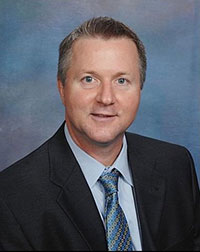MADISON, Wis. – Frequent face-to-face communication among all care team members in primary-care clinics may boost overall job satisfaction for health care professionals, according to a recent study by the University of Wisconsin School of Medicine and Public Health.

Marlon Mundt, PhD
In a survey of 143 health-care workers at five primary-care clinics (two urban, two suburban and one rural) in southern Wisconsin, overall job satisfaction was 5.8 on a seven-point scale (seven being extremely satisfied).
Clinicians and staff who frequently worked together throughout the day and were in the core of the face-to-face communication network showed far greater job satisfaction than those who were in the communication network periphery, according to a study led by Marlon Mundt, associate professor of family medicine at the UW School of Medicine and Public Health.
In contrast, health care professionals in an electronic communication network core did not have significantly greater overall job satisfaction when compared with clinicians and staff on the periphery.
“When it comes to team-based care it is not just what information health care professionals share, but how they share it that impacts their job satisfaction and their patients’ well-being,” Mundt said.
Mundt and his team conducted in-person interviews with each clinic employee. The participants, 95 percent female, in the study included medical doctors, doctors of osteopathic medicine, physician assistants, nurse practitioners, registered nurses, medical assistants, licensed practical nurses, laboratory technicians, radiology technicians, clinic managers, medical receptionists and other patient-care professionals.
Participants were asked to identify whom they interacted with about patient care at their clinics and how often, and if they interacted face-to-face and via electronic health records.
Through this, two patterns of communication interactions became apparent: clinicians and staff who communicated frequently every day formed a core group through which information flowed, in contrast to individuals on the periphery who were loosely connected to the communication network core and who did not interact with each other. This pattern was observed in both face-to-face communication and in electronic communication.
The study findings showed that job satisfaction varied by job title and percentage of full-time employment. The lowest rate of job satisfaction was with female physicians (5.1) while radiology technicians had the highest job satisfaction (6.4). Male physicians had a 6.1 rate. By employment status, the lowest job satisfaction was among health care professionals working part-time (5.0) compared to full-time employees (6.3).
The paper was recently published in the Annals of Family Medicine.
“Female physicians were satisfied with their variety of work, the opportunity to use their abilities, their income and recognition but dissatisfied with work hours and job overall,” Mundt said. “This finding may suggest a less-than-desirable work-life balance.”
The link between job satisfaction and membership in the face-to-face communication network core may relate to team cognition, which means team-shared understanding of the capabilities of each team member, who is good at what, and who should be assigned what at what time, Mundt said.
“Team cognition allows a team to be more than the sum of its parts,” he said. “It affords team flexibility and adaptability and enables teammates to relate to each other and to newly emerging information in the process of task performance,” he said.
In view of better team performance, team members might have better job satisfaction if they experience constructive working relationships and engage in shared team-care delivery, according to Mundt.
Structured team communication, such as daily huddles, might increase job satisfaction among health professionals in primary care teams, according to the study.
“To increase job satisfaction among primary-care professionals, it might be necessary to look beyond individual practitioners and to consider how to support frequent daily communication among all team members and how to allow all team members to be interconnected in their face-to-face communication and to share in team-based care,” he said.
Related article in UWSMPH Quarterly: Face-to-Face Communication Key to Job Satisfaction (PDF)
Published: October 2019 | Updated in January 2020 with Quarterly Link.
